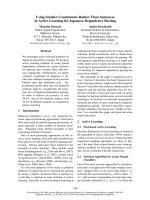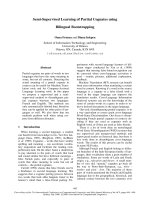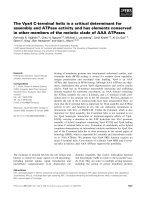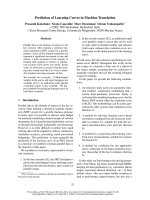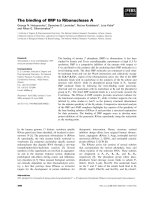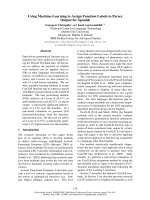Báo cáo khoa học: "Using Machine Learning Techniques to Build a Comma Checker for Basque" pdf
Bạn đang xem bản rút gọn của tài liệu. Xem và tải ngay bản đầy đủ của tài liệu tại đây (390.79 KB, 8 trang )
Proceedings of the COLING/ACL 2006 Main Conference Poster Sessions, pages 1–8,
Sydney, July 2006.
c
2006 Association for Computational Linguistics
Using Machine Learning Techniques to Build a Comma Checker for
Basque
Iñaki Alegria Bertol Arrieta Arantza Diaz de Ilarraza Eli Izagirre Montse Maritxalar
Computer Engineering Faculty. University of the Basque Country.
Manuel de Lardizabal Pasealekua, 1
20018 Donostia, Basque Country, Spain.
{acpalloi,bertol,jipdisaa,jibizole,jipmaanm}@ehu.es
Abstract
In this paper, we describe the research
using machine learning techniques to
build a comma checker to be integrated
in a grammar checker for Basque. After
several experiments, and trained with a
little corpus of 100,000 words, the sys-
tem guesses correctly not placing com-
mas with a precision of 96% and a re-
call of 98%. It also gets a precision of
70% and a recall of 49% in the task of
placing commas. Finally, we have
shown that these results can be im-
proved using a bigger and a more ho-
mogeneous corpus to train, that is, a
bigger corpus written by one unique au-
thor.
1 Introduction
In the last years, there have been many studies
aimed at building a grammar checker for the
Basque language (Ansa et al., 2004; Diaz De Il-
arraza et al., 2005). These works have been fo-
cused, mainly, on building rule sets ––taking into
account syntactic information extracted from the
corpus automatically–– that detect some erro-
neous grammar forms. The research here presen-
ted wants to complement the earlier work by fo-
cusing on the style and the punctuation of the
texts. To be precise, we have experimented using
machine learning techniques for the special case
of the comma, to evaluate their performance and
to analyse the possibility of applying it in other
tasks of the grammar checker.
However, developing a punctuation checker
encounters one problem in particular: the fact
that the punctuation rules are not totally estab-
lished. In general, there is no problem when us-
ing the full stop, the question mark or the ex-
clamation mark. Santos (1998) highlights these
marks are reliable punctuation marks, while all
the rest are unreliable. Errors related to the reli-
able ones (putting or not the initial question or
exclamation mark depending on the language, for
instance) are not so hard to treat. A rule set to
correct some of these has already been defined
for the Basque language (Ansa et al., 2004). In
contrast, the comma is the most polyvalent and,
thus, the least defined punctuation mark (Bayrak-
tar et al., 1998; Hill and Murray, 1998). The am-
biguity of the comma, in fact, has been shown
often (Bayraktar et al., 1998; Beeferman et al.,
1998; Van Delden S. and Gomez F., 2002).
These works have shown the lack of fixed rules
about the comma. There are only some intuitive
and generally accepted rules, but they are not
used in a standard way. In Basque, this problem
gets even more evident, since the standardisation
and normalisation of the language began only
about twenty-five years ago and it has not fin-
ished yet. Morphology is mostly defined, but, on
the contrary, as far as syntax is concerned, there
is quite work to do. In punctuation and style,
some basic rules have been defined and accepted
by the Basque Language Academy (Zubimendi,
2004). However, there are not final decisions
about the case of the comma.
Nevertheless, since Nunberg’s monograph
(Nunberg, 1990), the importance of the comma
has been undeniable, mainly in these two as-
pects: i) as a due to the syntax of the sentence
(Nunberg, 1990; Bayraktar et al., 1998; Garzia,
1997), and ii) as a basis to improve some natural
language processing tools (syntactic analysers,
error detection tools…), as well as to develop
some new ones (Briscoe and Carroll, 1995;
Jones, 1996). The relevance of the comma for the
syntax of the sentence may be easily proved with
some clarifying examples where the sentence is
understood in one or other way, depending on
whether a comma is placed or not (Nunberg,
1990):
a. Those students who can, contribute to the
United Fund.
b. Those students who can contribute to the
United Fund.
1
In the same sense, it is obvious that a well
punctuated text, or more concretely, a correct
placement of the commas, would help consider-
ably in the automatic syntactic analysis of the
sentence, and, therefore, in the development of
more and better tools in the NLP field. Say and
Akman (1997) summarise the research efforts in
this direction.
As an important background for our work, we
note where the linguistic information on the
comma for the Basque language was formalised.
This information was extracted after analysing
the theories of some experts in Basque syntax
and punctuation (Aldezabal et al., 2003). In fact,
although no final decisions have been taken by
the Basque Language Academy yet, the theory
formalised in the above mentioned work has suc-
ceeded in unifying the main points of view about
the punctuation in Basque. Obviously, this has
been the basis for our work.
2 Learning commas
We have designed two different but combinable
ways to get the comma checker:
based on clause boundaries
based directly on corpus
Bearing in mind the formalised theory of
Aldezabal et al. (2003)
1
, we realised that if we
got to split the sentence into clauses, it would be
quite easy to develop rules for detecting the exact
places where commas would have to go. Thus,
the best way to build a comma checker would be
to get, first, a clause identification tool.
Recent papers in this area report quite good
results using machine learning techniques. Car-
reras and Màrquez (2003) get one of the best per-
formances in this task (84.36% in test). There-
fore, we decided to adopt this as a basis in order
to get an automatic clause splitting tool for
Basque. But as it is known, machine learning
techniques cannot be applied if no training cor-
pus is available, and one year ago, when we star-
ted this process, Basque texts with this tagged
clause splits were not available.
Therefore, we decided to use the second al-
ternative. We had available some corpora of
Basque, and we decided to try learning commas
from raw text, since a previous tagging was not
needed. The problem with the raw text is that its
commas are not the result of applying consistent
rules.
1
From now on, we will speak about this as “the accepted theory of Basque
punctuation”.
Related work
Machine learning techniques have been applied
in many fields and for many purposes, but we
have found only one reference in the literature
related to the use of machine learning techniques
to assign commas automatically.
Hardt (2001) describes research in using the
Brill tagger (Brill 1994; Brill, 1995) to learn to
identify incorrect commas in Danish. The system
was developed by randomly inserting commas in
a text, which were tagged as incorrect, while the
original commas were tagged as correct. This
system identifies incorrect commas with a preci-
sion of 91% and a recall of 77%, but Hardt
(2001) does not mention anything about identify-
ing correct commas.
In our proposal, we have tried to carry out
both aspects, taking as a basis other works that
also use machine learning techniques in similar
problems such as clause splitting (Tjong Kim
Sang E.F. and Déjean H., 2001) or detection of
chunks (Tjong Kim Sang E.F. and Buchholz S.,
2000).
3 Experimental setup
Corpora
As we have mentioned before, some corpora
in Basque are available. Therefore, our first task
was to select the training corpora, taking into ac-
count that well punctuated corpora were needed
to train the machine correctly. For that purpose,
we looked for corpora that satisfied as much as
possible our “accepted theory of Basque punctu-
ation”. The corpora of the unique newspaper
written in Basque, called Egunkaria (nowadays
Berria), were chosen, since they are supposed to
use the “accepted theory of Basque punctuation”.
Nevertheless, after some brief verifications, we
realised that the texts of the corpora do not fully
match with our theory. This can be understood
considering that a lot of people work in a news-
paper. That is, every journalist can use his own
interpretation of the “accepted theory”, even if
all of them were instructed to use it in the same
way. Therefore, doing this research, we had in
mind that the results we would get were not go-
ing to be perfect.
To counteract this problem, we also collected
more homogeneous corpora from prestigious
writers: a translation of a book of philosophy and
a novel. Details about these corpora are shown in
Table 1.
2
Size of the corpora
Corpora from the newspaper Egun karia 420,000 words
Philosophy texts written by one unique author 25,000 words
Literature texts written by one unique author 25,000 words
Table 1. Dimensions of the used corpora
A short version of the first corpus was used in
different experiments in order to tune the system
(see section 4). The differences between the re-
sults depending on the type of the corpora are
shown in section 5.
Evaluation
Results are shown using the standard measures in
this area: precision, recall and f-measure
2
, which
are calculated based on the test corpus. The res-
ults are shown in two colums ("0" and "1") that
correspond to the result categories used. The res-
ults for the column “0” are the ones for the in-
stances that are not followed by a comma. On the
contrary, the results for the column “1” are the
results for the instances that should be followed
by a comma.
Since our final goal is to build a comma
checker, the precision in the column “1” is the
most important data for us, although the recall
for the same column is also relevant. In this kind
of tools, the most important thing is to first ob-
tain all the comma proposals right (precision in
columns “1”), and then to obtain all the possible
commas (recall in columns “1”).
Baselines
In the beginning, we calculated two possible
baselines based on a big part of the newspaper
corpora in order to choose the best one.
The first one was based on the number of
commas that appeared in these texts. In other
words, we calculated how many commas ap-
peared in the corpora (8% out of all words), and
then we put commas randomly in this proportion
in the test corpus. The results obtained were not
very good (see Table 2, baseline1), especially for
the instances “followed by a comma” (column
“1”).
The second baseline was developed using the
list of words appearing before a comma in the
training corpora. In the test corpus, a word was
tagged as “followed by a comma” if it was one of
the words of the mentioned list. The results (see
baseline 2, in Table 2) were better, in this case,
for the instances followed by a comma (column
named “1”). But, on the contrary, baseline 1
provided us with better results for the instances
not followed by a comma (column named “0”).
That is why we decided to take, as our baseline,
2
f-measure = 2*precision*recall / (precision+recall)
the best data offered by each baseline (the ones
in bold in table 2).
0 1
Prec. Rec. Meas. Prec. Rec. Meas.
baseline 1
0.927 0.924 0.926
0.076 0.079 0.078
baseline 2
0.946 0.556 0.700
0,096 0.596 0.165
Table 2: The baselines
Methods and attributes
We use the WEKA
3
implementation of these
classifiers: the Naive Bayes based classifier (Na-
iveBayes), the support vector machine based
classifier (SMO) and the decision-tree (C4.5)
based one (j48).
It has to be pointed out that commas were
taken away from the original corpora. At the
same time, for each token, we stored whether it
was followed by a comma or not. That is, for
each word (token), it was stored whether a
comma was placed next to it or not. Therefore,
each token in the corpus is equivalent to an ex-
ample (an instance). The attributes of each token
are based on the token itself and some surround-
ing ones. The application window describes the
number of tokens considered as information for
each token.
Our initial application window was [-5, +5];
that means we took into account the previous and
following 5 words (with their corresponding at-
tributes) as valid information for each word.
However, we tuned the system with different ap-
plication windows (see section 4).
Nevertheless, the attributes managed for each
word can be as complex as we want. We could
only use words, but we thought some morpho-
syntactic information would be beneficial for the
machine to learn. Hence, we decided to include
as much information as we could extract using
the shallow syntactic parser of Basque (Aduriz et
al., 2004). This parser uses the tokeniser, the
lemmatiser, the chunker and the morphosyntactic
disambiguator developed by the IXA
4
research
group.
The attributes we chose to use for each token
were the following:
word-form
lemma
category
subcategory
declension case
subordinate-clause type
3
WEKA is a collection of machine learning algorithms for data mining tasks
( />4
3
beginning of chunk (verb, nominal, enti-
ty, postposition)
end of chunk (verb, nominal, entity, post-
position)
part of an apposition
other binary features: multiple word to-
ken, full stop, suspension points, colon,
semicolon, exclamation mark and ques-
tion mark
We also included some additional attributes
which were automatically calculated:
number of verb chunks to the beginning
and to the end of the sentence
number of nominal chunks to the begin-
ning and to the end of the sentence
number of subordinate-clause marks to
the beginning and to the end of the sen-
tence
distance (in tokens) to the beginning and
to the end of the sentence
We also did other experiments using binary
attributes that correspond to most used colloca-
tions (see section 4).
Besides, we used the result attribute “comma”
to store whether a comma was placed after each
token.
4 Experiments
Dimension of the corpus
In this test, we employed the attributes de-
scribed in section 3 and an initial window of [-5,
+5], which means we took into account the pre-
vious 5 tokens and the following 5. We also used
the C4.5 algorithm initially, since this algorithm
gets very good results in other similar machine
learning tasks related to the surface syntax
(Alegria et al., 2004).
0 1
Prec. Rec. Meas. Prec. Rec. Meas.
100,000 train / 30,000 test 0,955 0,981 0,968 0,635 0,417 0,503
160,000 train / 45,000 test 0,947 0,981 0,964 0,687 0,43 0,529
330,000 train / 90,000 test
0,96 0,982 0,971 0,701 0,504 0,587
Table 3. Results depending on the size of corpora
(C4.5 algorithm; [-5,+5] window).
As it can be seen in table 3, the bigger the
corpus, the better the results, but logically, the
time expended to obtain the results also increases
considerably. That is why we chose the smallest
corpus for doing the remaining tests (100,000
words to train and 30,000 words to test). We
thought that the size of this corpus was enough to
get good comparative results. This test, anyway,
suggested that the best results we could obtain
would be always improvable using more and
more corpora.
Selecting the window
Using the corpus and the attributes described be-
fore, we did some tests to decide the best applic-
ation window. As we have already mentioned, in
some problems of this type, the information of
the surrounding words may contain important
data to decide the result of the current word.
In this test, we wanted to decide the best ap-
plication window for our problem.
0 1
Prec. Rec. Meas. Prec. Rec. Meas.
-5+5
0,955 0,981 0,968 0,635 0,417 0,503
-2+5
0,956 0,982 0,969 0,648 0,431 0,518
-3+5
0,957 0,979 0,968 0,627 0,441 0,518
-4+5
0,957 0,98 0,968 0,634 0,446
0,52
-5+2
0,956 0,982 0,969
0,65
0,424 0,514
-5+3
0,956 0,981 0,969 0,643 0,432 0,517
-5+4
0,955 0,982 0,968 0,64 0,417 0,505
-6+2
0,956 0,982 0,969 0,645 0,421 0,509
-6+3
0,956 0,982 0,969 0,646 0,426 0,514
-8+2
0,956 0,982 0,969 0,645 0,425 0,513
-8+3
0,956 0,979 0,967 0,615 0,431 0,507
-8+8
0,956 0,978 0,967 0,604 0,422 0,497
Table 4. Results depending on the application
window (C4.5 algorithm; 100,000 train / 30,000
test)
As it can be seen, the best f-measure for the
instances followed by a comma was obtained us-
ing the application window [-4,+5]. However, as
we have said before, we are more interested in
the precision. Thus, the application window [-5
,+2] gets the best precision, and, besides, its f-
measure is almost the same as the best one. This
is the reason why we decided to choose the [-5
,+2] application window.
Selecting the classifier
With the selected attributes, the corpus of
130,000 words and the application window of [-5
, +2], the next step was to select the best classifi-
er for our problem. We tried the WEKA imple-
mentation of these classifiers: the Naive Bayes
based classifier (NaiveBayes), the support vector
machine based classifier (SMO) and the decision
tree based one (j48). Table 5 shows the results
obtained:
4
0 1
Prec. Rec. Meas. Prec. Rec. Meas.
NB
0,948 0,956 0,952 0,376 0,335 0,355
SMO
0,936 0,994 0,965 0,672 0,143 0,236
J48
0,956 0,982 0,969 0,652 0,424 0,514
Table 5. Results depending on the classifier
(100,000 train / 30,000 test; [-5, +2] window).
As we can see, the f-measure for the instances
not followed by a comma (column “0”) is almost
the same for the three classifiers, but, on the con-
trary, there is a considerable difference when we
refer to the instances followed by a comma
(column “1”). The best f-measure gives the C4.5
based classifier (J48) due to the better recall, al-
though the best precision is for the support vector
machine based classifier (SMO). Definitively,
the Naïve Bayes (NB) based classifier was dis-
carded, but we had to think about the final goal
of our research to choose between the other two
classifiers. Since our final goal was to build a
comma checker, we would have to have chosen
the classifier that gave us the best precision, that
is, the support vector machine based one. But the
recall of the support vector machine based classi-
fier was not as good as expected to be selected.
Consequently, we decided to choose the C4.5
based classifier.
Selecting examples
At this moment, the results we get seem to be
quite good for the instances not followed by a
comma, but not so good for the instances that
should follow a comma. This could be explained
by the fact that we have no balanced training cor-
pus. In other words, in a normal text, there are a
lot of instances not followed by a comma, but
there are not so many followed by it. Thus, our
training corpus, logically, has very different
amounts of instances followed by a comma and
not followed by a comma. That is the reason why
the system will learn more easily to avoid the un-
necessary commas than placing the necessary
ones.
Therefore, we resolved to train the system
with a corpus where the number of instances fol-
lowed by a comma and not followed by a comma
was the same. For that purpose, we prepared a
perl program that changed the initial corpus, and
saved only x words for each word followed by a
comma.
In table 6, we can see the obtained results.
One to one means that in that case, the training
corpus had one instance not followed by a
comma, for each instance followed by a comma.
On the other hand, one to two means that the
training corpus had two instances not followed
by a comma for each word followed by a
comma, and so on.
0 1
Prec. Rec. Meas. Prec. Rec. Meas.
normal 0,955 0,981 0,968
0,635
0,417 0,503
one to one 0,989 0,633 0,772 0,164
0,912
0,277
one to two 0,977 0,902 0,938 0,367 0,725 0,487
one to three 0,969 0,934 0,951 0,427 0,621 0,506
one to four 0,966 0,952 0,959 0,484 0,575 0,526
one to five 0,966 0,961 0,963 0,534 0,568
0,55
one to six 0,963 0,966 0,964 0,55 0,524 0,537
Table 6. Results depending on the number of
words kept for each comma (C4.5 algorithm;
100,000 train / 30,000 test; [-5, +2] window).
As observed in the previous table, the best
precision in the case of the instances followed by
a comma is the original one: the training corpus
where no instances were removed. Note that
these results are referred as normal in table 6.
The corpus where a unique instance not fol-
lowed by a comma is kept for each instance fol-
lowed by a comma gets the best recall results,
but the precision decreases notably.
The best f-measure for the instances that
should be followed by a comma is obtained by
the one to five scheme, but as mentioned before,
a comma checker must take care of offering cor-
rect comma proposals. In other words, as the pre-
cision of the original corpus is quite better (ten
points better), we decided to continue our work
with the first choice: the corpus where no in-
stances were removed.
Adding new attributes
Keeping the best results obtained in the tests de-
scribed above (C4.5 with the [-5, +2] window,
and not removing any “not comma” instances),
we thought that giving importance to the words
that appear normally before the comma would in-
crease our results. Therefore, we did the follow-
ing tests:
1) To search a big corpus in order to extract
the most frequent one hundred words that pre-
cede a comma, the most frequent one hundred
pairs of words (bigrams) that precede a comma,
and the most frequent one hundred sets of three
words (trigrams) that precede a comma, and use
them as attributes in the learning process.
2) To use only three attributes instead of the
mentioned three hundred to encode the informa-
tion about preceding words. The first attribute
would indicate whether a word is or not one of
5
the most frequent one hundred words. The
second attribute would mean whether a word is
or not the last part of one of the most frequent
one hundred pairs of words. And the third attrib-
ute would mean whether a word is or not the last
part of one of the most frequent one hundred sets
of three words.
3) The case (1), but with a little difference:
removing the attributes “word” and “lemma” of
each instance.
0 1
Prec. Rec. Meas. Prec. Rec. Meas.
(0): normal 0,956 0,982 0,969 0,652 0,424 0,514
(1): 300 attributes +
0,96 0,983 0,972 0,696 0,486 0,572
(2): 3 attributes + 0,96 0,981 0,97 0,665 0,481 0,558
(3): 300 attributes +,
no lemma, no word
0,955 0,987 0,971
0,71
0,406 0,517
Table 7. Results depending on the new attributes
used (C4.5 algorithm; 100,000 train / 30,000 test;
[-5, +2] window; not removed instances).
Table 7 shows that case number 1 (putting the
300 data as attributes) improves the precision of
putting commas (column “1”) in more than 4
points. Besides, it also improves the recall, and,
thus, we improve almost 6 points its f-measure.
The third test gives the best precision, but the
recall decreases considerably. Hence, we decided
to choose the case number 1, in table 7.
5 Effect of the corpus type
As we have said before (see section 3), depend-
ing on the quality of the texts, the results could
be different.
In table 8, we can see the results using the dif-
ferent types of corpus described in table 1. Obvi-
ously, to give a correct comparison, we have
used the same size for all the corpora (20,000 in-
stances to train and 5,000 instances to test, which
is the maximum size we have been able to ac-
quire for the three mentioned corpora).
0 1
Prec. Rec. Meas. Prec. Rec. Meas.
Newspaper 0.923 0.977 0.949 0.445 0.188 0.264
Philosophy 0.932 0.961 0.946
0.583 0.44 0.501
Literature 0.925 0.976 0.95 0.53 0.259 0.348
Table 8. Results depending on the type of corpo-
ra (20,000 train / 5,000 test).
The first line shows the results obtained using
the short version of the newspaper. The second
line describes the results obtained using the
translation of a book of philosophy, written com-
pletely by one author. And the third one presents
the results obtained using a novel written in
Basque.
In any case, the results prove that our hypo-
thesis was correct. Using texts written by a
unique author improves the results. The book of
philosophy has the best precision and the best re-
call. It could be because it has very long sen-
tences and because philosophical texts use a
stricter syntax comparing with the free style of a
literature writer.
As it was impossible for us to collect the ne-
cessary amount of unique author corpora, we
could not go further in our tests.
6 Conclusions and future work
We have used machine learning techniques for
the task of placing commas automatically in
texts. As far as we know, it is quite a novel ap-
plication field. Hardt (2001) described a system
which identified incorrect commas with a preci-
sion of 91% and a recall of 77% (using 600,000
words to train). These results are comparable
with the ones we obtain for the task of guessing
correctly when not to place commas (see column
“0” in the tables). Using 100,000 words to train,
we obtain 96% of precision and 98.3% of recall.
The main reason could be that we use more in-
formation to learn.
However, we have not obtained as good res-
ults as we hoped in the task of placing commas
(we get a precision of 69.6% and a recall of
48.6%). Nevertheless, in this particular task, we
have improved considerably with the designed
tests, and more improvements could be obtained
using more corpora and more specific corpora as
texts written by a unique author or by using sci-
entific texts.
Moreover, we have detected some possible
problems that could have brought these regular
results in the mentioned task:
No fixed rules for commas in the Basque
language
Negative influence when training using
corpora from different writers
In this sense, we have carried out a little ex-
periment with some English corpora. Our hypo-
thesis was that a completely settled language like
English, where comma rules are more or less
fixed, would obtain better results. Taking a com-
parative English corpus
5
and similar learning at-
tributes
6
to Basque’s one, we got, for the in-
stances followed by a comma (column “1” in
tables), a better precision (%83.3) than the best
5
A newspaper corpus, from Reuters
6
Linguistic information obtained using Freeling (-
sevg.upc.es/freeling/)
6
one obtained for the Basque language. However,
the recall was worse than ours: %38.7. We have
to take into account that we used less learning at-
tributes with the English corpus and that we did
not change the application window chosen for
the Basque experiment. Another application win-
dow would have been probably more suitable for
English. Therefore, we believe that with a few
tests we easily would achieve a better recall.
These results, anyway, confirm our hypothesis
and our diagnosis of the detected problems.
Nevertheless, we think the presented results
for the Basque language could be improved. One
way would be to use “information gain” tech-
niques in order to carry out the feature selection.
On the other hand, we think that more syntactic
information, concretely clause splits tags, would
be especially beneficial to detect those commas
named delimiters by Nunberg (1990).
In fact, our main future research will consist
on clause identification. Based on the “accepted
theory of the comma”, we can assure that a good
identification of clauses (together with some sig-
nificant linguistic information we already have)
would enable us to put commas correctly in any
text, just implementing some simple rules. Be-
sides, a combination of both methods ––learning
commas and putting commas after identifying
clauses–– would probably improve the results
even more.
Finally, we contemplate building an ICALL
(Intelligent Computer Assisted Language Learn-
ing) system to help learners to put commas cor-
rectly.
Acknowledgements
We would like to thank all the people who have
collaborated in this research: Juan Garzia, Joxe
Ramon Etxeberria, Igone Zabala, Juan Carlos
Odriozola, Agurtzane Elorduy, Ainara Ondarra,
Larraitz Uria and Elisabete Pociello.
This research is supported by the University
of the Basque Country (9/UPV00141.226-
14601/2002) and the Ministry of Industry of the
Basque Government (XUXENG project,
OD02UN52).
References
Aduriz I., Aranzabe M., Arriola J., Díaz de Ilarraza
A., Gojenola K., Oronoz M., Uria L. 2004.
A Cascaded Syntactic Analyser for Basque
Computational Linguistics and Intelligent Text
Processing. 2945 LNCS Series.pg. 124-135.
Springer Verlag. Berlin (Germany).
Aldezabal I., Aranzabe M., Arrieta B., Maritxalar M.,
Oronoz M. 2003. Toward a punctuation checker
for Basque. Atala Workshop on Punctuation. Paris
(France).
Alegria I., Arregi O., Ezeiza N., Fernandez I., Urizar
R. 2004. Design and Development of a Named En%
tity Recognizer for an Agglutinative Language.
First International Joint Conference on NLP (IJC-
NLP-04). Workshop on Named Entity Recognition.
Ansa O., Arregi X., Arrieta B., Ezeiza N., Fernandez
I., Garmendia A., Gojenola K., Laskurain B.,
Martínez E., Oronoz M., Otegi A., Sarasola K.,
Uria L. 2004. Integrating NLP Tools for Basque in
Text Editors. Workshop on International Proofing
Tools and Language Technologies. University of
Patras (Greece).
Aranzabe M., Arriola J.M., Díaz de Ilarraza A. 2004.
Towards a Dependency Parser of Basque.
Proceedings of the Coling 2004 Workshop on Re-
cent Advances in Dependency Grammar. Geneva
(Switzerland).
Bayraktar M., Say B., Akman V. 1998. An Analysis of
English Punctuation: the special case of comma.
International Journal of Corpus Linguistics
3(1):pp. 33-57. John Benjamins Publishing Com-
pany. Amsterdam (The Netherlands).
Beeferman D., Berger A., Lafferty J. 1998. Cyber%
punc: a lightweight punctuation annotation system
for speech. Proceedings of the IEEE International
Conference on Acoustics, Speech and Signal Pro-
cessing, pages 689-692, Seattle (WA).
Brill, E. 1994. Some Advances in rule%based part of
speech tagging. In Proceedings of the Twelfth Na-
tional Conference on Artificial Intelligence. Seattle
(WA).
Brill, E. 1995. Transformation%based error%driven
learning and natural language processing: a case
study in part of speech tagging. Computational
Linguistics 21(4). MIT Press. Cambridge (MA).
Briscoe T., Carroll J. 1995. Developing and evaluat%
ing a probabilistic lr parser of part%of%speech and
punctuation labels. ACL/SIGPARSE 4th interna-
tional Workshop on Parsing Technologies, Prague /
Karlovy Vary (Czech Republic).
Carreras X., Màrquez L. 2003. Phrase Recognition by
Filtering and Ranking with Perceptrons. Proceed-
ings of the 4th RANLP Conference. Borovets (Bul-
garia).
Díaz de Ilarraza A., Gojenola K., Oronoz M. 2005.
Design and Development of a System for the De%
tection of Agreement Errors in Basque. CICLing-
2005, Sixth International Conference on Intelligent
Text Processing and Computational Linguistics.
Mexico City (Mexico).
Garzia J. 1997. Joskera Lantegi. Herri Arduralar-
itzaren Euskal Erakundea. Gasteiz, Basque Country
(Spain).
7
Hardt D. 2001. Comma checking in Danish. Corpus
linguistics. Lancaster (England).
Hill R.L., Murray W.S. 1998. Commas and Spaces:
the Point of Punctuation. 11
th
Annual CUNY Con-
ference on Human Sentence Processing. New
Brunswick, New Jersey (USA).
Jones B. 1996. Towards a Syntactic Account of Punc%
tuation. Proceedings of the 16th International Con-
ference on Computational Linguistics. Copenhagen
(Denmark).
Nunberg, G. 1990. The linguistics of punctuation.
Center for the Study of Language and Information.
Leland Stanford Junior University (USA).
Say B., Akman V. 1996. Information%Based Aspects
of Punctuation. Proceedings ACL/SIGPARSE In-
ternational Meeting on Punctuation in Computa-
tional Linguistics, pages pp. 49-56, Santa Cruz,
California (USA).
Tjong Kim Sang E.F. and Buchholz S. 2000. Intro%
duction to the CoNLL%2000 shared task: chunking.
In proceedings of CoNLL-2000 and LLL-2000.
Lisbon (Portugal).
Tjong Kim Sang E.F. and Déjean H. 2001. Introduc%
tion to the CoNLL%2001 shared task: clause identi%
fication. In proceedings of CoNLL-2001. Tolouse
(France).
Van Delden S., Gomez F. 2002. Combining Finite
State Automata and a Greedy Learning Algorithm
to Determine the Syntactic Roles of Commas. 14th
IEEE International Conference on Tools with Arti-
ficial Intelligence. Washington, D.C. (USA)
Zubimendi, J.R. 2004. Ortotipografia. Estilo liburu%
aren lehen atala. Eusko Jaurlaritzaren Argitalpen
Zerbitzu Nagusia. Gasteiz, Basque Country
(Spain).
8
